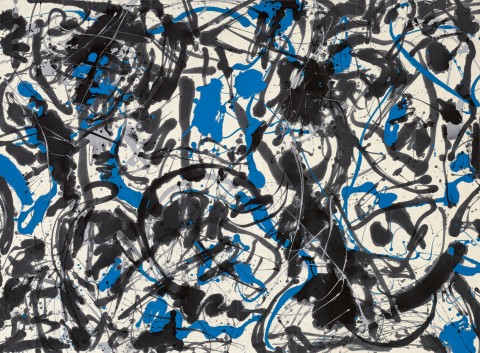ANTHROPOLOGY, 1973
DICK WATKINS
synthetic polymer paint on canvas
122.0 x 165.5 cm
signed, dated and inscribed with title verso: ANTHROPOLOGY DICK WATKINS 1973
Probably: Coventry Gallery, Sydney
Tolarno Galleries, Melbourne
The National Australia Bank Art Collection, acquired from the above in 1975 (label attached verso)
The Seventies: Australian Paintings and Tapestries from the Collection of National Australia Bank, National Gallery of Victoria, Melbourne, 15 October – 28 November 1982
The Seventies: Australian Paintings and Tapestries from the Collection of National Australia Bank, Geelong Art Gallery, Victoria, 30 April - 29 May 1988
The Seventies: Contemporary Australian Paintings from the National Australia Bank Collection, organised by Regional Galleries Association of New South Wales, New South Wales, cat. 28; and touring, Tamworth City Art Gallery, New South Wales, 24 May – 24 June 1990; Dubbo Regional Art Gallery, New South Wales, 11 July – 6 August 1990; Wagga Wagga City Art Gallery, New South Wales, 17 August – 10 September 1990; Moree Plains Regional Gallery, New South Wales, 3 October – 31 October 1990
Lindsay, R., The Seventies: Australian Paintings and Tapestries from the Collection of National Australia Bank, The National Bank of Australasia, Melbourne, 1982, pl. 95, p. 108 (illus.)
Dick Watkins is one of Australia finest formalist and painterly abstractionists of his generation. Critical and curatorial interest in his work has never hesitated in a career spanning more than five decades. He is an artist with the rare gift of taking his initial conception to realisation, and when the resolution of pictorial form is achieved, he can effortlessly change stylistic emphasis.
With an interest in European Modernism and North American abstraction, Watkins represents an autodidactic curiosity and understanding. Between 1959 – 1961 he travelled and saw the work of those who would shape his future. An unwavering interest in Picasso, Matisse and Jackson Pollock and other New School painters became the wellspring of his thinking about making paintings. This intellectual inquiry and working in the studio was always a source of influence, not appropriation. While the influences are often apparent they are used as aesthetic and stylistic yardsticks and become unmistakably personal. Watkins’ approach was explored in the exhibition Dick Watkins in Context: An Exhibition from the Collection of the National Gallery of Australia. In the company of greats from Picasso and Matisse to Robert Rauschenberg, de Kooning, Robert Motherwell and Jackson Pollock it was a gesture of astonishing respect for an Australian artist.1
Surface flatness, clarity of form and colour reached a distinctive culmination for Watkins when The Mooche, 1968 was exhibited and praised critically in The Field exhibition in 1968.2 A distinct shift followed.
In the earlier, Untitled, 1970, deftly controlled drips and sweeps of black paint become a stained choreographed calligraphy. The execution is flowing and lyrical with each action held in check.3 In Anthropology, painted three years later, a commanding robustness energises the surface. The looping and swirling lyricism in black, blue and silver-grey inflections is quite unlike Australian lyrical abstraction of the time – its unapologetic debt to Abstract Expressionism becomes a rethinking of a painterly genre which had held a lifelong preoccupation.
Watkins’ colour is invariably muted, no glaring primaries, no shrillness. One aspect of his post-colourfield work is the use of colour as a flat plane which is activated with rapidly brushed black gestures. Another is where coloured sgraffito-like forms are further delineated with black.
Anthropology embraces a confidence and sheer exuberance where correction, erasure and overpainting is not possible. The ambition and clarity of Watkins’ intention is unequivocal in its realisation.
1. Dick Watkins in Context: An Exhibition from the Collection of the National Gallery of Australia, National Gallery of Australia, Canberra, 1993
2. The Field, National Gallery of Victoria, Melbourne, 1968 – a landmark exhibition of Colourfield abstraction to mark the opening of the NGV at its new St Kilda Road premises. The Mooche, 1968, synthetic polymer paint and oil on canvas, collection of the Queensland Art Gallery / Gallery of Modern Art
3. Dick Watkins, Untitled, 1970, synthetic polymer paint on canvas, collection of the Art Gallery of New South Wales, Gift of Penelope Seidler, 2001
DOUG HALL AM
